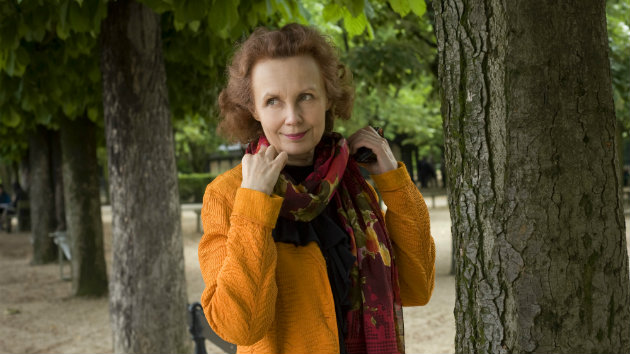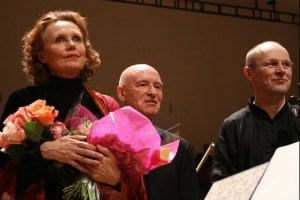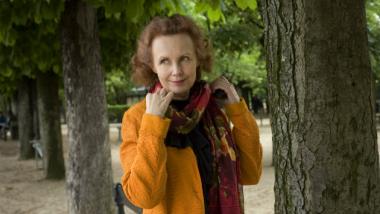
There’s something distinctly prismatic about the work of Finnish composer Kaija Saariaho.
Just one example: In densely clustered sections of the acclaimed composer’s Circle Map (2012), a 26-minute work that won the 2014 International Award at the British Composer Awards, flutes flash brilliantly like white light; percussion instrumentation creates columns, separating and clarifying; live string players and electronics bend sound inwardly, then burst unexpectedly in a variety of colors and textures. And yet, like other works in her extensive portfolio, there is unity — a continuum of structured sound for a listener to grasp and follow. The experience is illuminating and has made the work of the composer, who turns 63 on Oct. 14, enormously sought-after by major orchestras and opera companies.
Born in Helsinki in 1952 and exposed to modernist pioneers such as Paavo Heininen and Magnus Lindberg, Saariaho comes to the University of California, Berkeley Music Department this month as Bloch Professor in Residence. The position includes master classes and private lessons with student composers, a series of public lectures, and concerts in collaboration with Cal Performances and the eco ensemble, and the Berkeley Symphony’s West Coast premiere of Laterna Magica, a 2008 composition inspired by Ingmar Bergman, with Music Director Joana Carneiro conducting.
As if one premiere isn’t adequate display — and it’s not — of the significance of a composer who founded the progressive “Ears Open” group and developed industry-changing computer-assisted composition techniques at the IRCAM research institute in Paris, the unofficial “fall 2015 Saariaho season” includes UC Berkeley Music Department’s eco ensemble performing three of her works at Cal Performances’ Zellerbach Hall (Oct. 23); San Francisco Contemporary Music Players pairing Saariaho with composer and visual artist (and Saariaho’s husband) Jean-Baptiste Barriere at the Jewish Community Center of San Francisco (Oct. 24); and Left Coast Chamber Music Ensemble presenting two of her works in concerts in Mill Valley (Oct. 25) and San Francisco (Oct. 26). The Bloch Lectures (Oct. 12-Nov. 6 ) hosted on campus by the UC Berkeley Department of Music complete the offerings.
“The process of composing music, there are many layers of awareness and intuitive decisions,” Saariaho says in a phone interview one week before her arrival in the Bay Area. “They are superimposed on our technical decisions. You cannot justify them with exact details.”
Even the teaching of composition to students, she says, requires spaciousness, a certain distancing. Saahario reads the music with young composers and gives constructive feedback about strong points and undeveloped areas. But solutions? “I can’t find those for them,” she says. “I encourage them to find them on their own.”“When I’m still imagining the music in my mind before making notes is the most problematic. I try to imagine the music first: that’s very precious."
In her own practice, which varies, expectedly, from one composition to the next, she finds the beginning period most difficult. “When I’m still imagining the music in my mind before making notes is the most problematic. I try to imagine the music first: that’s very precious. The first idea includes the tempi, the orchestration, which are not difficult to imagine. But to reduce the possibilities for harmonic use and pitches, that is the most time consuming before starting the actual composition.”
Influences and actual sounds arrive continuously in her mind; emerging sometimes from childhood recall of Finland. “I had sensitivity to surrounding sounds. The sound came much from nature, the climate conditions, the coldness of the weather, the snow. The acoustics of contrasting nature has had an effect.” Not all of the sounds make it into her work, of course, but the constant listening, thinking and weeding can leave her drained, especially when composing a large work for orchestra or opera.
“We have things we hear and cannot get rid of. It’s hard to stop that process.
It would be good to relax. If it goes to the back of your head, to your subconscious, it is good. Sometimes that is when you find a solution.”
At other moments, clarity comes from collaborators. “Let’s take (flutist) Camilla Hoitenga,” Saariaho suggests. “We have a special way of collaborating: it’s more than 30 years that we are doing it. She knows me as a person and knows my music. I know her way of playing and reading my music. I write, we read it together, I ask her to find solutions for passages, we discuss the notation, the solutions, and finalize the details.”

Writing for specific instruments may determine technical details like pitch, range, tone, texture, and other aspects, but composing with a specific musician in mind, she can be even more precise and capitalize on specific physical capabilities or unique vocal characteristics. “A singing voice is the most detailed. I have in my mind a palette for every piece for a singer,” she says.
Although she and her husband, Barrière, share a vocation, Saariaho says they rarely discuss their work. “I don’t like to talk before it’s ready. He is similar. We are independent, then the other one is there to help if asked. It’s always very sensitive when you are creating something. It can be tricky to interfere too early.”
But that won’t cause her to be hesitant while discussing some aspects of composing with students, especially when it comes to the use of electronics and computers. “There are dangers,” she warns. During the advent of computer-assisted composing, enormous, room-sized computers lumbered through the process and required patience. Sometimes, it took more than a day to learn the result of an experimental effort to generate new sound. “People of my generation have the feeling of delay, but young people do not. I stress that I don’t choose to do something (with the computer) because it’s quicker. I keep it out of my composition. Quicker is never a reason for an artist.”
Noting the irony of a world in which technology is supposed to make lives simpler but everyone is lacking in time and constantly in a hurry, she says, “I know that the most precious thing for me is the time. To have time to work in peace.”

